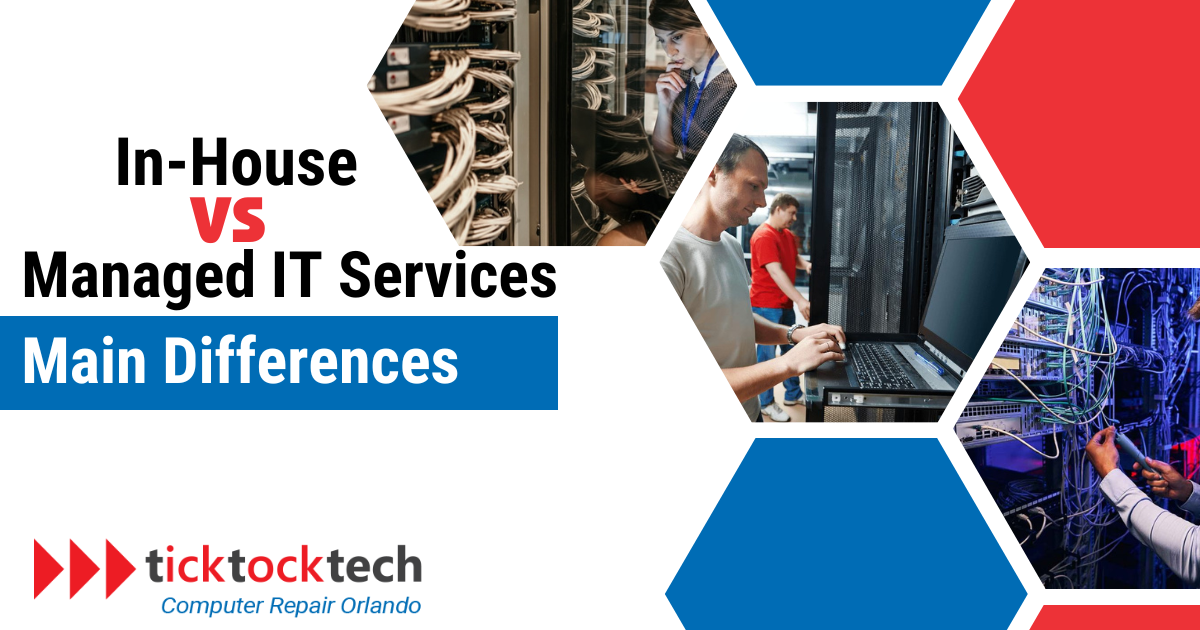Businesses and companies using IT infrastructures are prone to require IT services and maintenance. This is obviously because tech gadgets are to be maintained regularly, repaired fast, and even professionally set up. IT infrastructures like computers, servers, network, data facilities and more require regular monitoring and optimal security. Cyber attacks focus more on business, as they look to turn their dubious way into monetary value. It’s for businesses to be prepared before it ever happens and build up their security.
Companies however can prepare by having an internal technician to get the security measures done or outsource it to IT service companies. The choice depends on many factors and the comparison between the in-house and Managed IT services is being explored in this content. Let’s see what these services entail, and which method is suitable for your business.
What does In-House IT Services Entail?
In-house IT services involve establishing and maintaining an internal IT department within your organization. This team is responsible for handling all aspects of the company’s IT infrastructure, from daily operations to long-term strategic planning. In-house IT professionals are typically full-time employees who work exclusively for the organization.
The In-House Advantage:
- Immediate Response: With an in-house IT team, you have immediate access to technical support. When issues arise, your team is on-site and ready to address them promptly.
- Deep Understanding of Company Culture: In-house IT professionals become intimately familiar with your company’s operations, goals, and culture, allowing for a more tailored and integrated approach to IT solutions.
What Does Managed IT Services Entail?
Managed IT services, on the other hand, involve outsourcing your IT needs to a third-party provider. This external entity takes on the responsibility of managing your IT infrastructure, offering a range of services from basic support to advanced solutions. Managed service providers (MSPs) operate remotely and are typically engaged through a subscription-based model. For faster response, the MSP is advisable to be a technician IT service company near your location.

The Managed Advantage:
- Cost Efficiency: Managed IT services often provide a cost-effective alternative to maintaining an in-house team. Businesses can scale services based on their needs, paying only for what they require.
- Access to Specialized Expertise: MSPs usually have a diverse team of experts with specialized skills. This means you can benefit from a broader range of knowledge without the need to hire multiple specialists internally.
What is the Main Difference between In-house and Managed IT Services
The primary difference between in-house and managed IT services lies in the way the IT needs of an organization are met. In-house IT involves building and maintaining an internal team, providing immediate accessibility and an in-depth understanding of company operations. On the other hand, Managed IT Services mean outsourcing to an external provider, offering cost efficiency, specialized expertise, and scalability. The decision is based on various criteria, including the necessity for quick support, financial constraints, and the desire for specialized knowledge. In the end, companies need to balance the benefits and drawbacks to properly traverse the rapidly changing tech market and match their specific aims.
Pros and Cons of In-house IT Services
Pros:
- Immediate Accessibility: Having an in-house team means they are readily available, often in the same physical location as the rest of the company. This accessibility allows for quick response times in case of emergencies.
- In-Depth Knowledge of Company Operations: In-house teams intimately understand the ins and outs of the company’s specific operations, tailoring solutions to meet unique needs.
- Direct Control: Organizations maintain direct control over all aspects of their IT operations, from hiring decisions to daily tasks.
Cons:
- Costly: Building and maintaining an in-house team can be expensive. Salaries, benefits, and ongoing training contribute to a significant financial investment.
- Limited Expertise: In-house teams may have limitations in terms of expertise. They might not have the same breadth of experience as a dedicated managed IT service provider.
- Resource Dependency: In-house teams rely on internal resources, which can lead to potential bottlenecks during peak times or specialized projects.
Pros and Cons of Managed IT Services
Pros:
- Cost Efficiency: Managed IT services often operate on a subscription or pay-as-you-go model, providing a cost-effective solution compared to maintaining a full in-house team.
- Specialized Expertise: External providers bring a wealth of expertise across various industries. This specialized knowledge can be beneficial for solving complex problems or implementing new technologies.
- Scalability: Managed IT services offer flexibility and scalability. As your business grows, the services can be easily adjusted to accommodate changing needs.
Cons:
- Potential for Communication Gaps: Despite advanced communication tools, the physical separation of an external provider can lead to potential communication gaps compared to an in-house team.
- Less Immediate Response: While managed IT services offer support, the response time might not be as immediate as having an in-house team on-site.
- Less Intimate Understanding of Company Culture: External providers might not fully grasp the intricacies of a company’s culture and specific internal processes.
Which is better between In-House IT Services and Managed IT Services
The choice between managed and in-house IT services is based on several criteria that are particular to each company, and consider the organization’s size, spending capacity, and unique IT requirements before making a choice.
When evaluating in-house IT services, take into account things like the necessity of quick, on-site support for your business operations, the specific IT requirements that are closely linked to your operations, and whether you have the funds to dedicate to hiring and training internal IT staff.
In contrast, criteria for managed IT services include the requirement for access to a wide range of specialized IT experience. The need to control IT expenditures and profit from a predictable, subscription-based approach. Whether or not scalability and flexibility are necessary to match the changing needs of the business.
Conclusions
Depending on your company’s needs, finances, and growth trajectory, you must decide between managed and in-house IT services. While in-house services are more costly, they offer immediate accessibility and an in-depth understanding of corporate procedures. However, there is a chance that managed IT services will have communication problems while providing scalability, specialized knowledge, and cost-effectiveness.
When making decisions about their IT infrastructure, organizations need to carefully weigh the advantages and disadvantages of new technology. Whether you choose to engage an internal team or outsource to a managed IT services provider, the most crucial thing is to make sure your choice is per the goals and priorities of your business.

